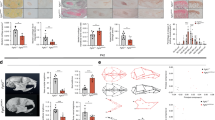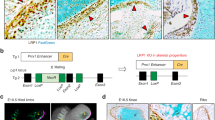Abstract
Fibroblast growth factor receptor 3 (Fgfr3) is a tyrosine kinase receptor expressed in developing bone, cochlea, brain and spinal cord. Achondroplasia, the most common genetic form of dwarfism, is caused by mutations in FGFR3. Here we show that mice homozygous for a targeted disruption of Fgfr3 exhibit skeletal and inner ear defects. Skeletal defects include kyphosis, scoliosis, crooked tails and curvature and overgrowth of long bones and vertebrae. Contrasts between the skeletal phenotype and achondroplasia suggest that activation of FGFR3 causes achondroplasia. Inner ear defects include failure of pillar cell differentiation and tunnel of Corti formation and result in profound deafness. Our results demonstrate that Fgfr3 is essential for normal endochondral ossification and inner ear development.
This is a preview of subscription content, access via your institution
Access options
Subscribe to this journal
Receive 12 print issues and online access
$209.00 per year
only $17.42 per issue
Buy this article
- Purchase on SpringerLink
- Instant access to full article PDF
Prices may be subject to local taxes which are calculated during checkout
Similar content being viewed by others
References
Basilico, C. & Moscatelli, D. The FGF family of growth factors and oncogenes. Adv. Cancer Res. 59, 115–165 (1992).
Muenke, M. & Schell, U. Fibroblast-growth-factor receptor mutations in human skeletal disorders. Trends Genet. 11, 308–313 (1995).
Johnson, D.E. & Williams, L.T. Structural and functional diversity in the FGF receptor multigenefamily Adv. Cancer. Res. 60, 1–41 (1993).
Hebert, J.M., Rosenquist, T., Gotz, J. & Martin, G.R. FGF5 as a regulator of the hair growth cycle: Evidence from targeted and spontaneous mutations. Cell. 78, 1017–1025 (1994).
Feldman, B., Poueymirou, W., Papaioannou, V.E., DeChiara, T.M. & Goldfarb, M. Requirement of FGF-4 for postimplantation mouse development. Science. 267, 246–249 (1995).
Peters, K.G., Werner, S., Chen, G. & LT.Two FGF receptor genes are differentially expressed in epithelial and mesenchymal tissues during limb formation and organogenesis in the mouse. Development. 114, 233–243 (1992).
Peters, K., Ornitz, D.M., Werner, S. & Williams, L. Unique expression pattern of the FGF receptor 3 gene during mouse organogenesis. Dev. Biol. 155, 423–430 (1993).
Rousseau, F. et al. Mutations in the gene encoding fibroblast growth factor receptor-3 in achondroplasia. Nature. 371, 252–254 (1994).
Shiang, R. et al. Mutations in the transmembrane domain of FGFR3 cause the most common genetic form of dwarf ism, achondroplasia. Cell. 78, 335–342 (1994).
Tavormina, P.L. et al. Thanatophoric dysplasia (types I and II) caused by distinct mutations in fibroblast growth factor receptor 3. Nature Genet. 9, 321–328 (1995).
Briner, J., Giedion, A. & Spycher, M.A. Variation of quantitative and qualitative changes of enchondral ossification in heterozygous achondroplasia. Pathol. Res. Pract. 187, 271–278 (1991).
Rimoin, D.L., Hughes, G.N., Kaufman, R.L., Rosenthal, R.E., McAlister, W.H. & Silberberg, R. Endochondral ossification in achondroplastic dwarfism. NewEngl. J. Med. 283, 728–735 (1970).
Meyers, G.A., Orlow, S.J., Munro, I.R. & Jabs, E.W. Fibroblast growth factor receptor 3 (FGFR3) transmembrane mutation in Crouzon syndrome with acanthosis nigricans. Nature Genet. 11, 462–464 (1995).
Chellaih, AT., McEwen, D.G., Werner, S., Xu, J & Ornitz, D.M. Fibroblast growth factor receptor (FGFR) 3: alternative splicing in immunoglobulin-like domain III creates a receptor highly specific for acidic FGF/FGF-1. J. Biol. Chem. 269, 11620–11627 (1994).
Caplan, A.I. & Pechak, D.G. The cellular and molecular embryology of bone formation, in Bone and Mineral Research Vol. 5. (ed. Peck, W. A.) 117–183. (Elsevier Science Publishers, New York, 1987).
lannotti, J.P. Growth plate physiology and pathology. Orthop. Clin. North Am. 21, 1–17 (1990).
Kikuchi, K. & Hilding, D. The development of the organ of Corti in the mouse. Acta. Otolaryngol. (Stockh.) 60, 207–222 (1965).
Pinelli, V., Masi, R., Pierro, V. & Tieri, L Otologic impairments in achondroplasia: a nosologic assessment. In Human Achondroplasia. (ed. Nicoletti, B., Kopits, S.E., Ascani, E. & McKusick, V.A.) 149–152 (Plenum Press, New York & London, 1988).
Engstrom, H., Ades, H.W. & Andersson, A. Structural pattern of the organ of Corti. (Almqvist & Wiksell, Stockholm, 1966).
Mikaelian, D.O., Warfield, D. & Norris, O. Genetic progressive hearing loss in the C57/bl6 mouse. Acta Otolaryngol. 77, 327–334 (1974).
Ponseti, I.V. Skeletal growth in achondroplasia. J. Bone Joint Surg. Am. 52-A, 701–716 (1970).
Kato, Y. & Iwamoto, M. Fibroblast growth factor is an inhibitor of chondrocyte terminal differentiation. J. Biol. Chem. 265, 5903–5909 (1990).
Baron, J. et al. Induction of growth plate cartilage ossification by basic fibroblast growth factor. Endocrinology. 135, 2790–2793 (1994).
Pirvola, U. et al. The site of action of neuronal acidic fibroblast growth factor is the organ of Corti of the rat cochlea. Proc. Natl. Acad. Sci. USA. 92, 9269–9273 (1995).
Ernfors, P., Van De Water, T., Loring, J. & Jaenisch, R. Complementary roles of BDNF and NT-3 in vestibular and auditory development. Neuron. 14, 1153–1164 (1995).
Sidman, R.L., Green, M.C. & Appel, S.H. Catalog of the neurological mutants of the mouse. (Harvard University Press, Cambridge, Massachusetts, 1965).
Tybulewicz, V.L.J., Crawford, C.E., Jackson, P.K., Bronson, R.T. & Mulligan, R.C. Neonatal lethality and lymphopenia in mice with a homozygous disruption of the c-abl proto-oncogene. Cell. 65, 1153–1163 (1991).
Chisaka, O. & Capecchi, M.R. Regionally restricted developmental defects resulting from targeted disruption of the mouse homeobox gene hox-1. Nature. 350, 473–479 (1991).
Shen, M.M. . ef al. Expression of LIF in transgenic mice results in altered thymic epithelium and apparent interconversion of thymic and lymph node morphologies. EMBO J. 13, 1375–1385 (1994).
Ornitz, D.M. & Leder, P. Ligand specificity and heparin dependence of fibroblast growth factor receptors 1 and 3. J. Biol. Chem. 267, 16305–16311 (1992).
Perez-Castro, A.V., Wilson, J. & Altherr, M.R. Genomic organization of the mouse fibroblast growth factor receptor 3 (Fgfr3) gene. Genomics. 30, 157–162 (1995).
Lufkin, T, Dierich, A., LeMeur, M., Mark, M. & Chambon, P. Disruption of the Hox-1.6 homeobox gene results in defects in a region corresponding to its rostral domain of expression. Cell. 66, 1105–1119 (1991).
Wallin, J. et al. The role of Pax-1 in axial skeleton development. Development. 20, 1109–1121 (1994).
Bohne, B.A. Location of small cochlear lesions by phase contrast microscopy prior to thin sectioning. Laryngoscope. 82, 1–16 (1972).
Richardson, K.C., Jarrett, L & Finke, E.H. Embedding in epoxy resin for ultrathin sectioning for electron microscopy. Stain Tech. 35, 313–323 (1960).
Henry, K.R. Auditory nerve and brain stem volume-conducted potentials evoked by pure-tone pips in the CBA/J laboratory mouse. Audiology. 18, 93–108 (1979).
Henry, K.R. & Chole, R.A. Cochlear electrical activity in the C57BL/6 laboratory mouse: volume-conducted vertex and round window responses. Acta Otolaryngol. 87, 61–68 (1979).
Davis, H. ef al. Acoustic trauma in the guinea pig. J. Acoust Soc. Am. 25, 1180–1189 (1953).
Author information
Authors and Affiliations
Rights and permissions
About this article
Cite this article
Colvin, J., Bohne, B., Harding, G. et al. Skeletal overgrowth and deafness in mice lacking fibroblast growth factor receptor 3. Nat Genet 12, 390–397 (1996). https://doi.org/10.1038/ng0496-390
Received:
Accepted:
Issue Date:
DOI: https://doi.org/10.1038/ng0496-390
This article is cited by
-
Cell unit-inspired natural nano-based biomaterials as versatile building blocks for bone/cartilage regeneration
Journal of Nanobiotechnology (2023)
-
Biological and clinical implications of FGFR aberrations in paediatric and young adult cancers
Oncogene (2023)
-
Cochlear protein biomarkers as potential sites for targeted inner ear drug delivery
Drug Delivery and Translational Research (2020)
-
Nuclear Fibroblast Growth Factor Receptor Signaling in Skeletal Development and Disease
Current Osteoporosis Reports (2019)
-
Mechanisms of synovial joint and articular cartilage development
Cellular and Molecular Life Sciences (2019)



